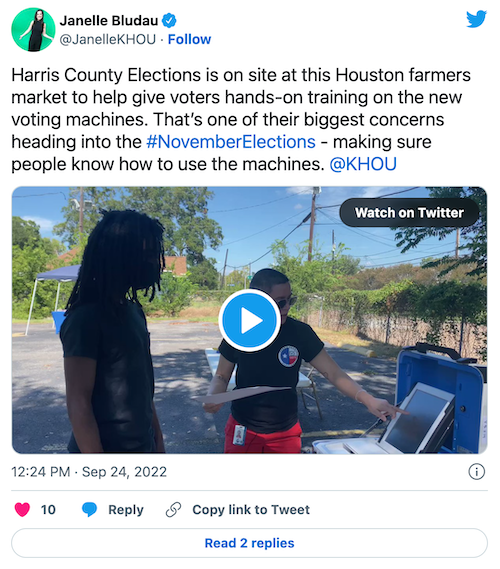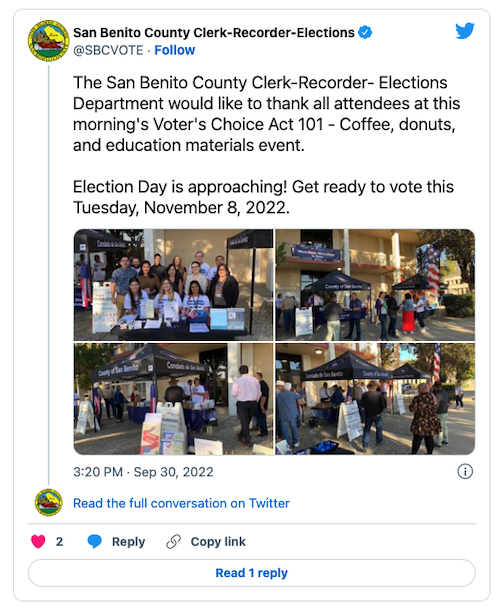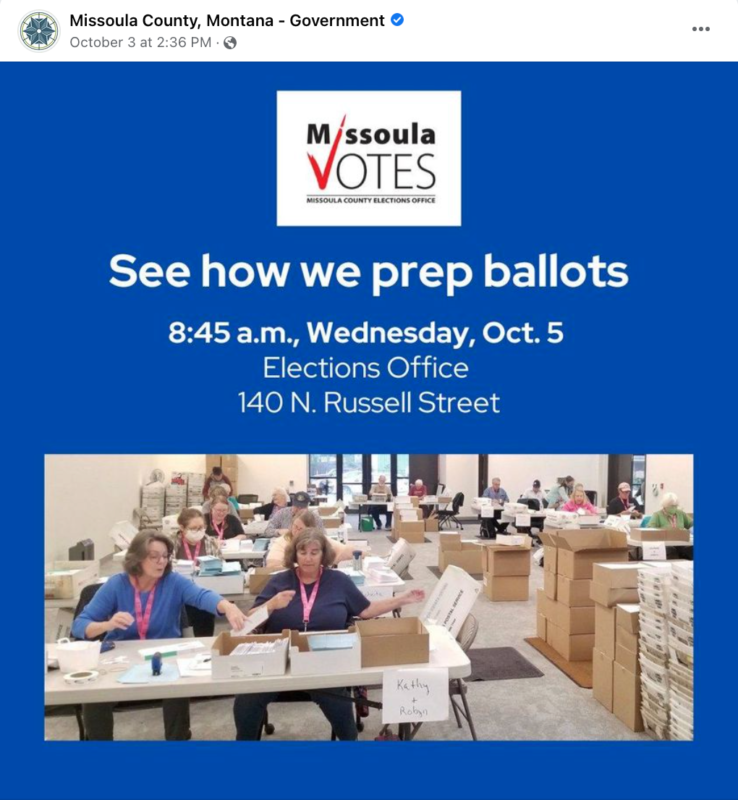How Election Officials are Preparing for Election Day
This article was featured in our ELECTricity newsletter in October 2022. Sign up to receive more success stories from election offices across the country.
With Election Day just three weeks away, and early voting already underway in many states, election officials are in the final stages of preparing to ensure the General Election is a success. They’re working overtime to finalize voting locations, mail out absentee ballots, make sure they have enough poll workers, test voting equipment, and much, much more. As you continue with your preparations, we’re sharing a few ways that your fellow election officials are prepping for Election Day. We hope this list will inspire you through these next few weeks. And who knows? It just might also spark some ideas for you to implement for future elections in your jurisdiction.
Using new technology
Throughout the country, we’re seeing election offices introduce new technologies to automate systems, increase efficiency, and improve the voter experience. This year, Marion County, Indiana is using a new system to deliver absentee ballots with increased accuracy, security, and speed—eliminating the manual work required in previous years. Marion County is the first in the state to use the new technology, which can prepare thousands of absentee ballots an hour. “This system will prevent a voter from not having their ballot counted due to human error on our end,” said Deputy Director Russell Hollis.
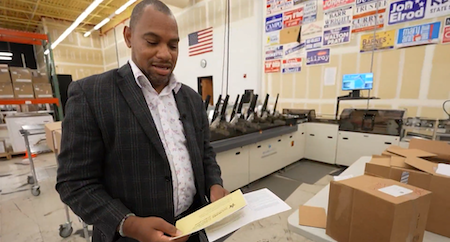
In Virginia Beach, Virginia, election officials are debuting an iPad system to speed up the check-in process for early voters. Director of Elections Christine Lewis said the new technology takes just one minute to check-in a voter, compared with traditional methods that might take as long as five. Those time savings are significant, especially considering that over 400 voters showed up on the first day of early voting. Kern County, California is also expecting to reap benefits from using e-poll books for the first time. While most other large counties in the state had already purchased e-poll books ahead of the 2020 election, Kern County didn’t have the funds to do so. “This resulted in Kern having the highest number of provisional ballots in the state in the November 2020, the 2021 recall election, and in the June primary,” County Auditor-Controller Clerk Mary Bedard explains. Mary says the new poll books should reduce the need for provisional ballots, since poll workers will easily be able to check voters’ eligibility.
In Orange County, North Carolina, election officials are using a simple wait time tracker on their website for the first time. It’s nothing fancy, just a table for voters to see how long the wait times are at each of their six early voting sites during the early voting period. To see how this tool works, watch this six minute demo. If you would like this wait time tool set up for your jurisdiction, reach out to the U.S. Digital Response team. They created this tool for Orange County in just two days, and could have you up and running in about a day.
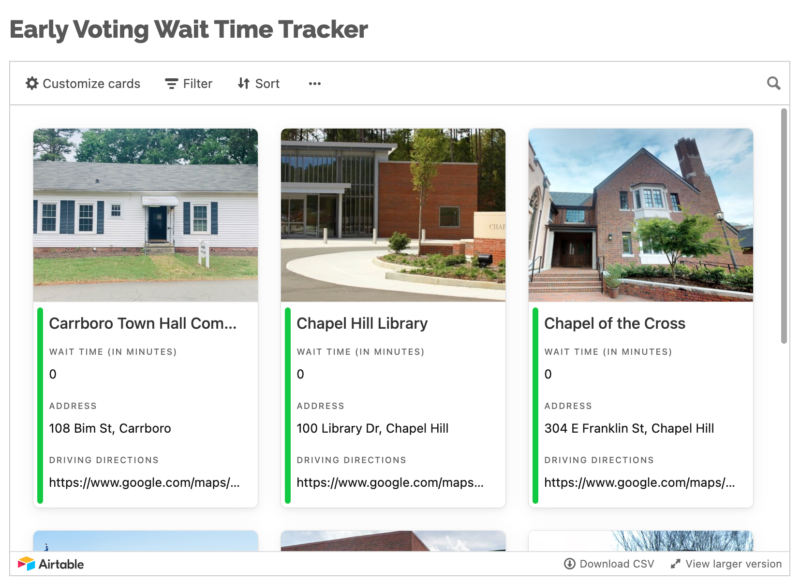
Preparing Voters for Changes
Across the country, election offices are using new voting systems for the General Election, and similarly inviting the public to test them out. Election officials in Harris County, Texas have hosted demonstrations at farmers markets, health fairs, and churches. “We’re just trying to get people confident when they go and cast a ballot in November,” said Harris County Elections Administration Communications Deputy Director Nadia Hakim. During the General Election in Shelby County, Tennessee, voters will use new machines for the first time in 20 years. To give voters the chance to test them out before Election Day, election officials have hosted multiple events in libraries and other community spaces. Plus, they created a quick video about how to use the new machines which they shared on their website.
In Ulster County, New York—home of the viral “I Voted” sticker that we all know and love—voters had the unique opportunity to try out a new voting system during a mock election. Voters’ feedback will help guide the county’s decision about whether to purchase the system for future elections. “I’m glad these are open to the public before they put them out. I think that’s really important,” said one voter who tested the new ADA-compliant voting machine.
Election officials are not only preparing voters for changes to how they vote, but also where they vote. In San Benito County, California, voters will cast their ballots at vote centers as opposed to traditional polling places, since the county recently adopted the Voters Choice Act. In order to inform the public about this new model, the election team hosted a “Voters Choice Act 101” event, where they provided coffee, donuts, and educational materials.
Gearing up for an election is already a challenging feat, but throw a natural disaster into the mix and preparations become much more complicated. In southwest Florida counties hit by Hurricane Ian, election officials are keeping voters in the loop about changes to their polling places, and calling for additional resources for voters affected by the storm. And despite remarkable challenges, all 67 Florida counties managed to get mail ballots out to voters in time.
Sharing Trusted Election Information
As many voters continue to have concerns about the election process, one of election officials’ most important tasks is to proactively share trusted information ahead of the November election. And they’re working harder than ever to do so in creative, engaging ways.
As part of the North Carolina Trusted Elections Tour, election officials teamed up with a bipartisan group of cybersecurity experts and election law attorneys to participate in 14 town halls—one for every congressional district. The events addressed public concerns around election security and voting access, while encouraging voters to get involved in the election administration process. Election officials in jurisdictions including Dakota County, Minnesota, Davis County, Utah, Kalamazoo County, Michigan, Knox County, Ohio, Missoula County, Montana, and Shasta County, California have hosted similar events to improve voters’ understanding of the election process and ultimately boost confidence.
In addition to answering voters’ questions, election officials are also inviting them to see how election processes work firsthand. In Tarrant County, Texas, the elections team invited the public to a voting equipment test for the first time, in hopes of increasing transparency and trust in the system. “I think it’s important to show that we have a valid election system,” said one Tarrant County resident. “We have really good processes in place…and I appreciate that Tarrant County is trying to get the confidence of every single voter here.”
A key part of sharing trusted election information is combating misinformation. Election officials in jurisdictions including Pitt County, North Carolina and Spokane County, Washington continue to engage the media to dispel misinformation. And more and more are using their election websites to highlight facts, including the Dallas County, Texas elections department that recently set up a webpage for debunking rumors for the first time.
Forging Community Partnerships
Ahead of the General Election, election officials are teaming up with sports teams, universities, and other partners to make registering and voting as enjoyable and convenient as possible. The Duval County, Florida Supervisor of Elections has partnered with the Jacksonville Jaguars football team to provide registration information and nonpartisan voting resources. Plus, the election team hosted a poll worker training session at the Stadium in September. Thanks to the partnership, 300 poll workers showed up—a tremendous increase from previous years when only a few dozen people attended those sessions.
Election officials in Maricopa County, Arizona attended a Phoenix Suns open practice event to provide information about how fans can get involved for the upcoming election. And in Boston, Massachusetts, voters can use Fenway Park as an early voting site, thanks to a partnership between the city’s Election Commission and the Red Sox.
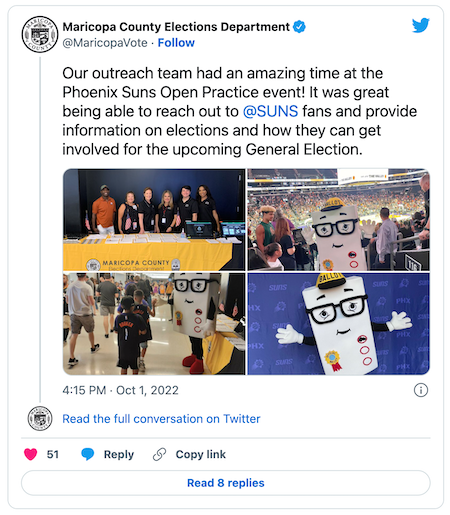
Election officials have also been engaging college students to encourage them to participate in the voting process. In Ann Arbor, Michigan and Alamance County, North Carolina, students at the University of Michigan and Elon University will be able to vote on campus, thanks to partnerships forged by their local election officials. And in Lansing City, Michigan, election officials are engaging even younger members of their community. At their annual “Souls to the Polls Trunk or Treat” event, children can trick or treat at the city clerk’s office, while their parents can register to vote or vote early.
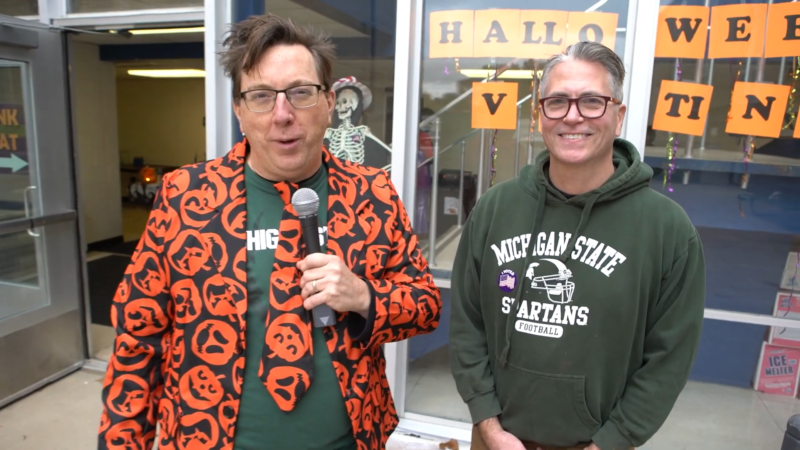
How are you preparing?
What is your election office doing to prepare for the General Election? Is there a unique new technology, outreach method, or process you’re proud of? Are you decorating your election office for Halloween? Bringing your pets into the office? We’d love to hear from you and better yet, see a picture! Email us at: [email protected]
